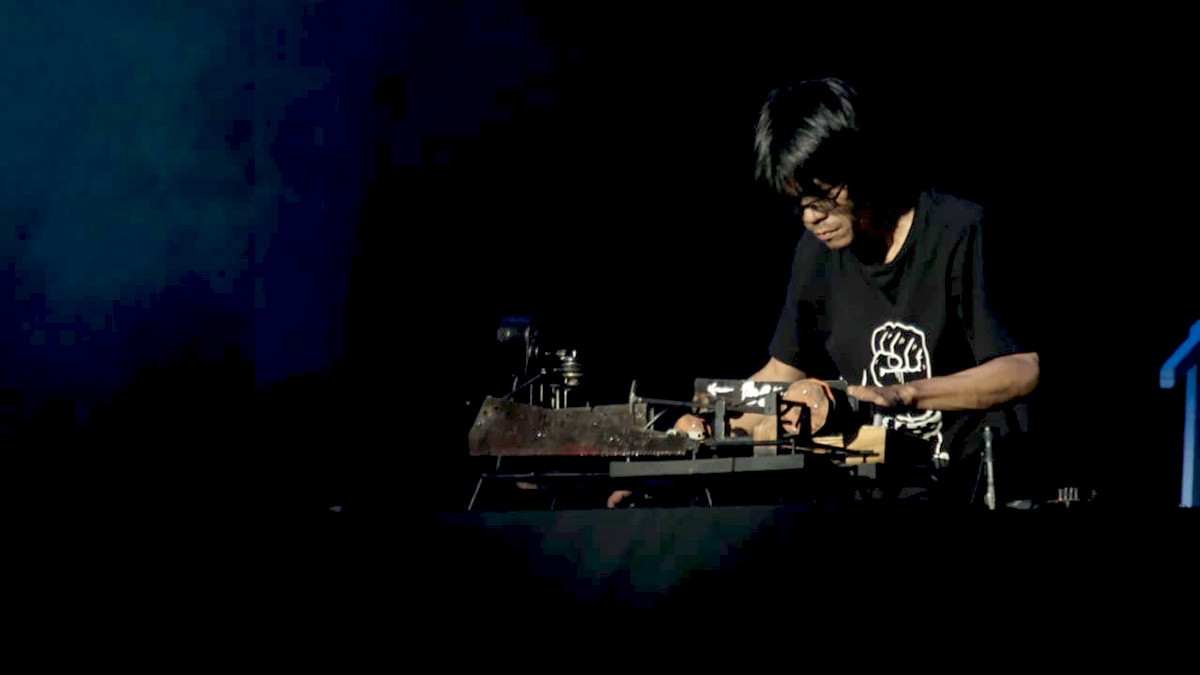- Environmental damage in the Ogan Komering Ilir region of South Sumatra is driving social shifts and threatening Indigenous cultural traditions.
- During the Panggung Kecil Festival in Palembang, the capital of South Sumatra, musicians Fikri M.S. and Silo Siswanto showcased new work exploring the cultural impact of environmental destruction.
- The musical tradition of tembangan in Silo’s home region risks being lost, but similar genres continue to flourish among Indigenous communities living in intact rainforests.
PALEMBANG, Indonesia — Silo Siswanto picks a rejung melody over a guitar fretboard under stage lights in the Teater Potlot in the city of Palembang, evoking the fragility of the remaining forests across Indonesia’s South Sumatra province.
“Before, when I was little, you could still get to experience clear water in the peat marsh,” Silo said on the sidelines of the Panggung Kecil Festival, which was sponsored by Mongabay Indonesia and Sriwijaya Cultural Park and took place in September and October.
Silo traces back his ancestry some 13 generations in the Rawang community in Tulung Selapan, a peatland community in South Sumatra’s Ogan Komering Ilir district, around 350 kilometers (220 miles) northwest of Indonesia’s capital, Jakarta.
But since around the 1980s, the community found itself increasingly encroached on by fish farms and oil palm plantations.

South Sumatra lost almost a quarter of its old-growth forest between 2002 and 2020, according to Global Forest Watch, a satellite monitoring service, as oil palm and paper industries drove wholesale changes to land use across swaths of peatlands across Sumatra.
However, Silo’s home district, Ogan Komering Ilir, outpaced the provincial average, losing 36% of its humid forests during the same period. That transformation prompted complex social shifts and migration away from Tulung Selapan, he said.
“You used to come across freshwater fish all the time: snakehead fish, catfish, mystus,” he said. “Those are just memories now.”
Silo blames the collapse of forests around Tulung Selapan for the endangerment of unique cultural traditions, a knock-on effect of environmental harm that is often overlooked.
“Our culture has changed,” he said. “Many traditional arts like tembangan are fading away.”
Tembangan is a musical tradition from Tulung Selapan where a melody is accompanied by spoken word, typically lyrical scenes of customary tradition, faith and humanity’s relationship with the environment.
In addition to performing as a musician, Silo researches music at the Persatuan Guru Republik Indonesia (PGRI) University in Palembang.
When Silo began poring over music in communities around South Sumatra, he found a rich equivalent to tembangan holding out in forests around the Bukit Barisan mountains, south of Tulung Selapan, home to the Semende and Pasemah Indigenous communities.

Rejung music originated with the Semende, a society in Sumatra where assets are inherited down the female line.
“Because the nature has been kept intact in Semende, rejung can also continue to flourish,” Silo said.
The music reminded him of his late mother taking care of him when he was still a young boy in Tulung Selapan, before the environment changed as he grew up.
In Semende’s matrilineal societies, it is mothers and daughters who own the fields and farms under the tradition of tunggu tubang, owing to a belief that women make wiser stewards of both nature and material goods.
To the Semende people, the word umak means both mother and nature.
Rejung music consists of two strands, in which the “mother” is a calm and reliable rhythm, while the “child” is a boisterous melody played at higher octaves.
“The ayunan umak [mother strand] is played by the bass, which tends to be in a monotone,” Silo said. “While the ayunan anak [child strand] is played at a high pitch with the creativity and freedom to shape a melody.”
Silo performed the rejung piece on classical guitar, supported by visuals from multimedia artist Dyan Junecia.
Other pieces from Festival Panggung Kecil included a dance recital by Sonia Anisah Utami and spoken word by Fadil Semende, while artist Fikri M.S. performed a more visceral presentation of forest destruction in South Sumatra.
Fikri’s performance, titled “Artmosf,” used a theremin, an instrument using variable light and shadow, to modulate a bleak composition of chainsaws, excavators, falling trees and cries of animals.

“I hope this work can build the listener’s awareness to protect or preserve the forest,” Fikri said.
For Silo, conservation of much of South Sumatra’s diversity of rural cultures depends on safeguarding the landscape in which such traditions formed, just as the ayunan umak and ayunan anak depend on one another.
“Rejung is a sustainable portrait of nature,” Silo said. “If the nature in Semende is damaged, the rejung may also be lost, just like the tembangan in Tulung Selapan.”
This story was reported by Mongabay’s Indonesia team and first published here on our Indonesian site on Oct. 20, 2021.
FEEDBACK: Use this form to send a message to the author of this post. If you want to post a public comment, you can do that at the bottom of the page.
